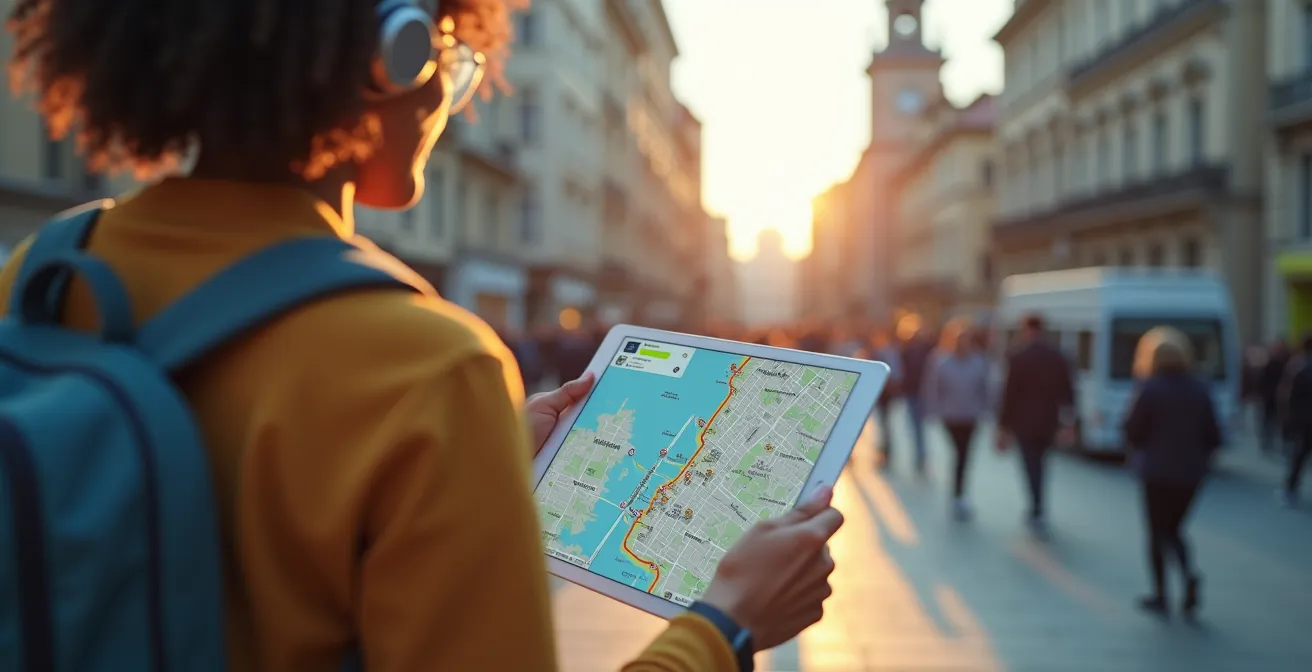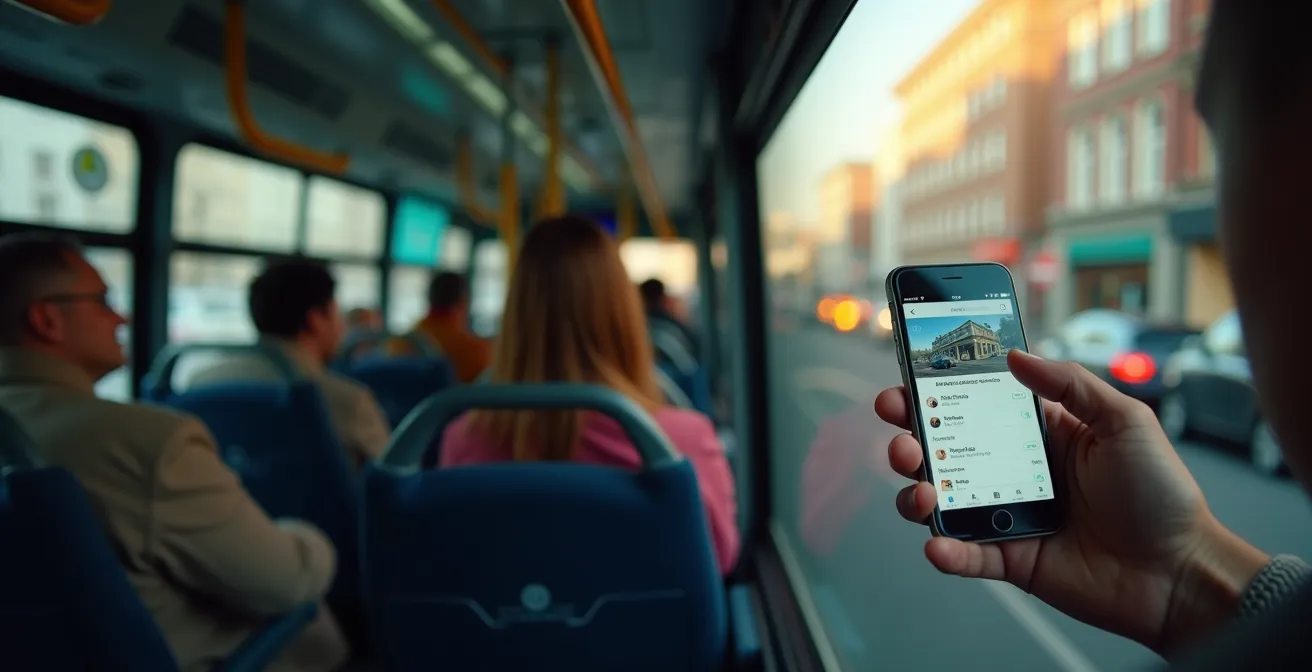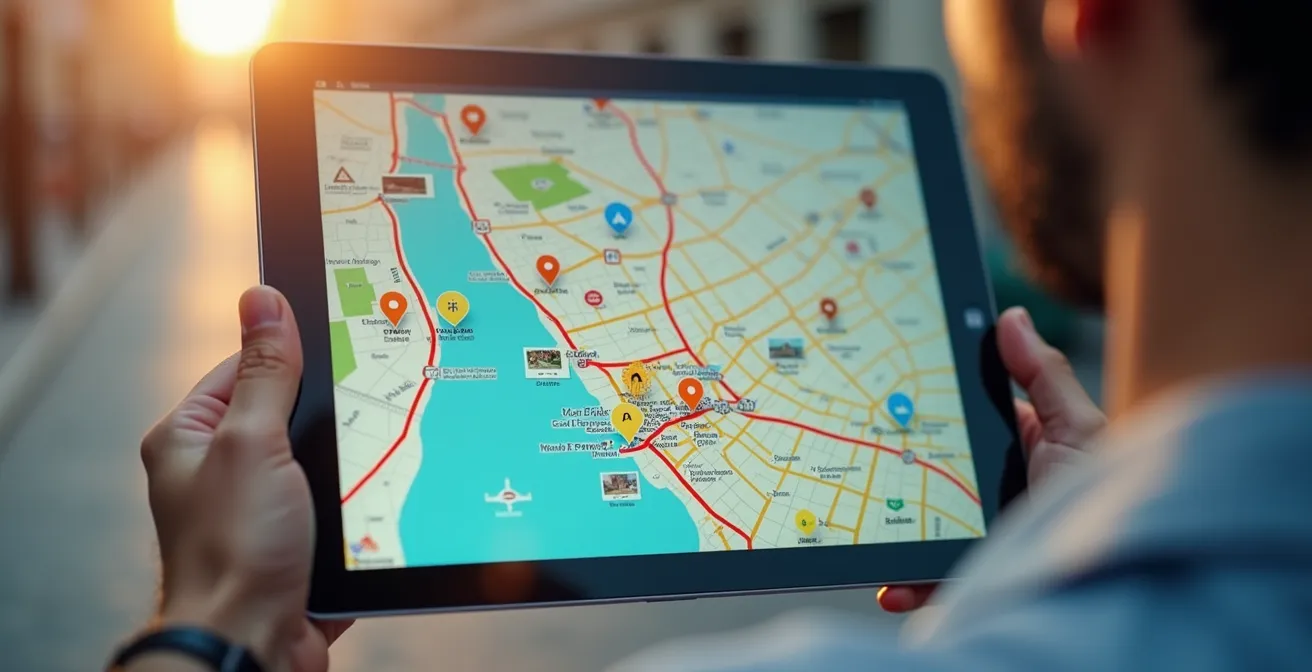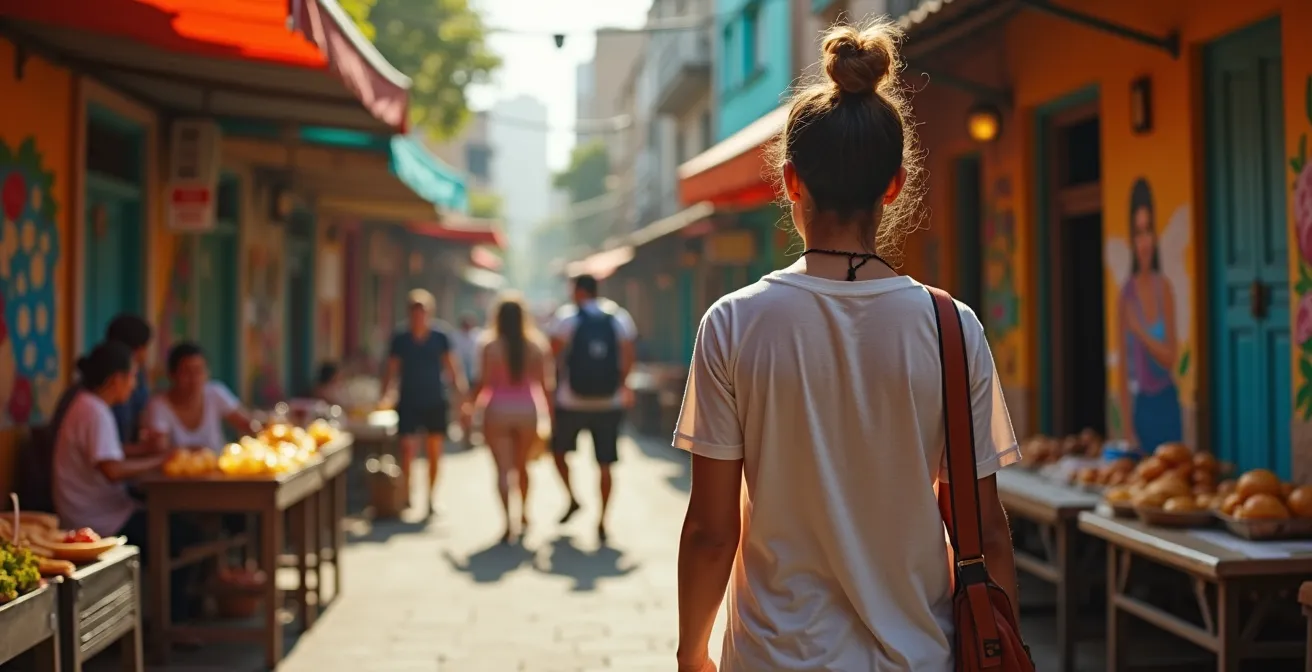
The classic city break often conjures images of ticking off a list of landmarks from the top deck of a bus, a whirlwind of photo opportunities that can feel more like a task than an experience. While traditional bus tours offer a glimpse into a city’s highlights, they can leave you feeling like a passive observer, watching the city’s real life unfold from behind a window. The true art of maximizing a short trip lies not in seeing more, but in seeing smarter. It’s about shifting from a passive checklist mentality to one of active, strategic engagement.
This approach transforms sightseeing from a hurried marathon into a meaningful journey of discovery. It’s about understanding that the soul of a city is found not just in its grand monuments, but in the quiet side streets, the bustling local markets, and the unexpected moments of connection. By blending intelligent planning with a willingness to explore, you can craft an experience that is both efficient and deeply immersive, creating memories that last long after the vacation ends.
Your smart city break blueprint
- Challenge the passive nature of conventional tours for deeper, more authentic engagement.
- Utilize AI and advanced digital mapping tools for truly personalized itinerary planning.
- Balance iconic must-sees with immersive local experiences by focusing on neighborhoods.
- Integrate flexibility and spontaneity to create a fulfilling and enjoyable travel pace.
Deconstructing the ‘iconic sightseeing’ paradox: why bus tours aren’t always the smartest route
The allure of a guided bus tour is its perceived efficiency—a promise to deliver a city’s greatest hits in a tidy, predictable package. However, this convenience often comes at the cost of genuine discovery. The experience can become a series of superficial stops at crowded tourist hubs, leaving little room for personal exploration or spontaneous immersion. Today’s savvy traveler increasingly seeks more autonomy and depth, with research showing a clear trend toward independent exploration. In fact, studies indicate a growing preference for self-guided discovery, with an estimated 65% of travelers preferring self-guided tours.
The core issue with a rigid tour structure is its one-size-fits-all approach. It treats every traveler the same, ignoring individual interests and curiosities. This contrasts sharply with the proactive mindset of a smart traveler, who uses technology and strategic planning to craft a journey tailored to their passions. The goal shifts from merely seeing landmarks to understanding their context and experiencing the culture that surrounds them.
Bus tours often impose a rigid schedule and a basic route, limiting genuine discovery and personal engagement.
– Action Tour Guide Editorial Team, The Trouble with Tour Buses
As one traveler noted when comparing experiences, self-guided tours offer complete flexibility and a far more immersive adventure, whereas bus tours, though convenient, often feel rushed and impersonal. This philosophy of strategic engagement is about reclaiming your time and attention to focus on what truly matters to you, turning a simple city break into a rich, personalized adventure.
This distinction in travel styles is fundamental. On one hand, you have the structured, passive observation from a distance. On the other, the dynamic, hands-on experience of navigating a city on your own terms, armed with tools that unlock its hidden layers.

The contrast highlights a modern travel dilemma: choosing between the ease of a packaged tour and the rewarding challenge of forging your own path. The smart traveler finds a middle ground, using technology not to replace discovery, but to enhance it, ensuring every moment of their trip is spent meaningfully.
Beyond the map pin: leveraging AI and digital tools for personalized discovery
Gone are the days when a paper map was your only guide. Today, a suite of powerful digital tools can transform your smartphone into a personal concierge, helping you design a truly customized exploration. Advanced features in applications like Google Maps allow you to go beyond simple routing. You can create custom maps layered with your interests—pinpointing artisanal coffee shops, independent bookstores, or specific architectural styles—turning a generic city grid into a personalized treasure map.
The latest evolution in travel planning comes from AI-powered itinerary planners. These platforms are designed to understand your unique tastes and craft suggestions that go beyond the obvious tourist trail, leading to an 80% rise in AI trip planner adoption among discerning travelers. By analyzing your interests, they can recommend niche museums, local eateries, and hidden gems that align with your passions, creating a journey that feels uniquely yours. These tools don’t just plan; they inspire, helping you discover facets of a city you might have otherwise missed.
What are AI itinerary planners?
AI itinerary planners are intelligent applications that create personalized travel schedules. They analyze your interests, budget, and travel style to suggest attractions, restaurants, and hidden gems, optimizing your route for a seamless and customized experience.
AI-powered trip planning with Tripplanner.ai
Tripplanner.ai uses AI to create personalized travel itineraries balancing iconic sights with hidden gems, adapting dynamically to traveler preferences and real-time data.
The goal is to use these digital aids to complement, not replace, the iconic sights. A visit to a world-famous museum can be enriched by discovering a nearby local artisan market suggested by your AI planner. This strategy allows you to experience the city’s celebrated highlights while also uncovering its more authentic, everyday charm.

Ultimately, these tools empower you to move beyond the map pin and engage with a city on a deeper level. By leveraging technology to curate your adventure, you can ensure your itinerary is a perfect reflection of your curiosity, blending landmark visits with the joy of discovering something completely unexpected.
How to discover local gems with digital tools
- Create customized maps with layered interests on Google Maps.
- Use AI itinerary planners that suggest spots based on personal preferences.
- Leverage social media geotags for hidden locations.
- Engage with local forums or apps for real-time tips.
The art of strategic sightseeing: balancing immersion with efficiency
Maximizing a city break isn’t about rushing from one spot to another; it’s about making deliberate choices that blend efficiency with deep, memorable experiences. The first step is to develop a personal framework for prioritizing attractions. Instead of relying solely on generic “must-see” lists, curate your own based on genuine interest and the opportunity to experience local flavour. For instance, when planning a trip to see the most popular monuments in France, consider which ones resonate with you personally and how you can experience the neighborhood around them.
This is where principles of “slow travel” can be integrated even into a short trip. Focus on exploring one or two neighborhoods thoroughly rather than zigzagging across the city. By immersing yourself in a specific area, you can visit an iconic landmark and then experience the local life that thrives in its shadow—discover a nearby bakery, relax in a local park, or browse a unique shop. This approach fosters a much deeper connection to the place.
Of course, efficiency remains important, especially when it comes to popular attractions with long queues. Tactical approaches like pre-booking tickets are essential. Understanding when a “skip-the-line” pass truly adds value can transform your experience from a frustrating wait into pure enjoyment.
Dynamic queue management at Uffizi Gallery, Florence
The Uffizi Gallery uses predictive data and advanced reservation systems to reduce queuing times and optimize visit flow, enhancing visitor experience through strategic pre-booking.
Skip-the-line and pre-booking are tactical tools that maximize enjoyment by reducing wait times while allowing focus on meaningful experiences rather than rushing.
– Rick Steves, How to Avoid Lines and Crowds in Europe
To help visualize the trade-offs, consider this comparison between different sightseeing philosophies.
| Criteria | Guided Bus Tours | Strategic Self-Planning |
|---|---|---|
| Flexibility | Low, fixed schedule | High, personalized timing |
| Immersion | Surface level | Deep local experience |
| Efficiency | High, fast-paced | Balanced with immersive moments |
| Cost | Higher for groups | Often lower, scalable |
By adopting a strategic mindset, you can strike the perfect balance, ensuring your city break is both highly efficient and deeply rewarding.
Crafting your enjoyable pace: integrating spontaneity and local culture
The most memorable trips are often those that leave room for the unexpected. A perfectly maximized itinerary isn’t a rigid script; it’s a flexible framework that invites serendipity. By scheduling your “must-see” attractions but leaving large blocks of time free, you create space for spontaneous discoveries—whether it’s stumbling upon a vibrant street market, lingering in a charming café, or following an interesting side street just to see where it leads.
A city’s culinary scene is one of the most direct gateways to its culture. Instead of treating meals as a mere necessity, integrate them as a core part of your sightseeing. Plan to visit a local food market, take a cooking class, or book a table at a restaurant known for its authentic regional dishes. These experiences provide not just nourishment but also a rich, sensory immersion into the local way of life. They become memorable highlights in their own right, transforming your trip from a visual tour to a multi-sensory adventure.
A traveler’s reflection on this approach captures it perfectly: incorporating downtime and local culture makes a city break far more fulfilling than simply checking off sights. This ensures the “enjoyable” aspect of your trip is never lost in the quest for efficiency.

Ultimately, a successful city break links discovery to personal fulfillment. It’s about creating a pace that feels right for you, balancing planned activities with the freedom to wander and connect. This mindful approach guarantees you return home not just with photos, but with cherished memories and a genuine feel for the city’s soul. When you balance structure with freedom, you might even discover a magical destination for your next journey.
Building flexibility into city exploration
- Reserve key activities but leave ample free time for serendipity.
- Prioritize local food experiences as integral parts of your itinerary.
- Use apps to find local events or pop-ups on the go.
- Opt for walkable neighborhoods to absorb local atmosphere.
Key takeaways
- Shift from passive sightseeing to active, strategic engagement for a more meaningful travel experience.
- Leverage AI planners and digital maps to create a personalized itinerary beyond the typical tourist spots.
- Balance iconic attractions with deep dives into local neighborhoods to capture the city’s true essence.
- Build flexibility into your schedule to allow for spontaneous discoveries and genuine cultural immersion.
Frequently asked questions on city sightseeing tips
Is it possible to see iconic sights without a guided tour?
Absolutely. With strategic planning, pre-booked tickets, and digital tools like audio guides and custom maps, you can explore iconic sights independently. This allows you to go at your own pace and combine famous landmarks with local discoveries for a more personal experience.
How much time should I leave for spontaneous activities?
A good rule of thumb is to plan no more than one or two key activities per day. This leaves several hours free for spontaneous exploration, allowing you to wander through neighborhoods, follow your curiosity, and discover hidden gems that aren’t in the guidebooks.
Are AI travel planners really better than guidebooks?
AI travel planners offer a key advantage: personalization. While guidebooks provide excellent general information, AI tools can tailor recommendations to your specific interests, budget, and travel style. They can also adapt in real-time to changes in weather or your mood, offering a dynamic and customized alternative.
How can I experience local culture on a short trip?
Focus on immersive experiences rather than just observation. Prioritize visiting a local food market, taking public transportation, exploring a non-touristy neighborhood, or simply spending an hour in a local café. These small actions provide a much deeper sense of the city’s culture than just visiting landmarks.